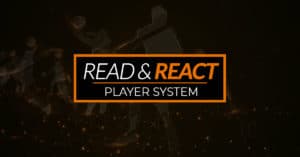Can you have an “Inside-Out” philosophy and yet play primarily from a 5 OUT formation? Does your formation have anything to do with having an “Inside-Out” philosophy?
I don’t think that many will disagree with me when I say that the team that gets the most shots in the lane usually wins over the long haul. But most coaches interpret “Going Inside” as planting Post Players inside for the entire possession until the team gets them the ball and they can go one-one-one. I want to re-interpret what it means to have an “Inside-Out” philosophy. Scoring inside is not limited to a Power Shot by your biggest player. Scoring inside is scoring inside, whether it’s a lay-up by your smallest player, or a put-back from an offensive rebound.
My “Inside-Out” philosophy can be summed up pretty easily: I don’t care HOW or WHO scores in the lane, I simply want someone threatening to score in the lane at all times.
READ & REACT reflects this philosophy two ways:
- It gives ALL players a chance to score in the lane.
- It’s usually someone different every time the ball moves.
I intentionally designed EVERY action (or Layer) in the Read & React to send someone to the rim, i.e., a scoring threat IN THE LANE. In other words, the Read & React is DESIGNED with an “Inside-Out” philosophy. There’s no other offense or offensive system that sends more players to the rim with each movement of the ball than the Read & React. There’s no other offense that will DEMAND the defense to guard the lane more than the Read & React.
But this is NOT always accomplished with a Post Player on the ball-side begging for the ball!
Let me make this point a Layer at a time:
Layer 1: When a pass is made, what happens? The passer must basket cut – Inside Threat.
Layer 2 & 13: When you feed the post, what happens? The passer Laker Cuts to the rim (that includes the X-cut as well.)
Layer 3: When dribbled at, that player must cut to the rim – Inside Threat.
Layer 4, 5, 6: When someone drives, …well, that’s obvious.
Layer 7: What about a Pin & Skip? The Pin Screener is now INSIDE (threatening the rim).
Layer 8 addresses a failed attempt to drive INSIDE.
Layer 9: When a Post player screens for a cutter, Layer 9 teaches them to “Shape Up” into the lane and call for the ball – an Inside Threat.
Layer 10: When a Back Screen is set, the user of the screen cuts to the basket – an Inside Threat.
Layer 11: Multiple Screens have multiple INSIDE threats – cutters AND screeners.
Layer 12: After the ball screen is set, there are TWO players threatening INSIDE: the ball handler (trying to get to the rim) and the screener who rolls to the basket.
Layer 13: see Layer 2.
Layer 14: When a cutter is forced to make a corner, a back screen is set, sending a cutter to the rim – see Layer 10.
Layer 15: When the Power Dribbler hands off the ball, they roll to the basket – an Inside Threat.
Layer 16: The Advanced Post Slide is initiated with someone driving to the rim – Inside Threat. And one of the Advanced post slides gives the post a better chance to receive the ball INSIDE.
Layers 17-20 involves Read & React in the Full-Court: fast break lay-ups, early offense, threatening to score INSIDE.
Now that I’ve beaten that point to death, consider what will hinder the Inside Threats of each action above. Is it weakside defense? No, I’m not worried about helping defenders because we have an answer for that (Pin & Skip) that leads to another threat INSIDE. The one thing that that is guaranteed to inhibit all of the “Inside-Threat-Actions” that I listed above is post players who play on the ball-side-mid-post FOR THE ENTIRE POSSESSION.
Instead of “hogging the lane” ALL of the time, Post Players (or anyone who tries to score in the post) can be more effective by doing the following:
- Use all three posting spots: High post, Mid-post, Short Corner. Not only do the High Post and Short Corner leave the lane open, but simply switching between the positions will leave the rim open for other players.
- Set screens for cutters (Layer 9) – this allows both the cutter and the post to threaten inside. The Post uses the screen to get open inside.
- Occasionally step out and set a back screen, then roll back into the post. (Layer 10)
- Don’t always follow the ball. Remain on the weak-side occasionally and set a Pin Screen. This opens the lane up on ball-side and if the Skip pass is thrown, your Pin Screen will set you up to receive the ball where you want it – INSIDE!
There’s more weapons that these, but you get the idea. Get active and share the lane.
CLOSING THOUGHT: Why have Inside-Out intentions to your offense? Because going inside first will force the defense to GUARD the lane, which usually means helping and rotating by the defense. (If they don’t, you’ll score inside.) If the defense must guard the lane, then when the ball is moved on the outside, the defense will be forced to rotate, close out, and change positions; and that kind of movement creates scoring opportunities for everyone.






